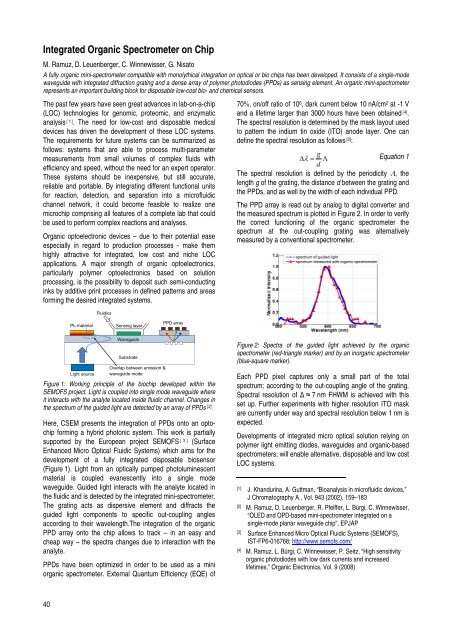CSEM Scientific and Technical Report 2008
CSEM Scientific and Technical Report 2008
CSEM Scientific and Technical Report 2008
You also want an ePaper? Increase the reach of your titles
YUMPU automatically turns print PDFs into web optimized ePapers that Google loves.
Integrated Organic Spectrometer on Chip<br />
M. Ramuz, D. Leuenberger, C. Winnewisser, G. Nisato<br />
A fully organic mini-spectrometer compatible with monolythical integration on optical or bio chips has been developed. It consists of a single-mode<br />
waveguide with integrated diffraction grating <strong>and</strong> a dense array of polymer photodiodes (PPDs) as sensing element. An organic mini-spectrometer<br />
represents an important building block for disposable low-cost bio- <strong>and</strong> chemical sensors.<br />
The past few years have seen great advances in lab-on-a-chip<br />
(LOC) technologies for genomic, proteomic, <strong>and</strong> enzymatic<br />
analysis [ 1] . The need for low-cost <strong>and</strong> disposable medical<br />
devices has driven the development of these LOC systems.<br />
The requirements for future systems can be summarized as<br />
follows: systems that are able to process multi-parameter<br />
measurements from small volumes of complex fluids with<br />
efficiency <strong>and</strong> speed, without the need for an expert operator.<br />
These systems should be inexpensive, but still accurate,<br />
reliable <strong>and</strong> portable. By integrating different functional units<br />
for reaction, detection, <strong>and</strong> separation into a microfluidic<br />
channel network, it could become feasible to realize one<br />
microchip comprising all features of a complete lab that could<br />
be used to perform complex reactions <strong>and</strong> analyses.<br />
Organic optoelectronic devices – due to their potential ease<br />
especially in regard to production processes - make them<br />
highly attractive for integrated, low cost <strong>and</strong> niche LOC<br />
applications. A major strength of organic optoelectronics,<br />
particularly polymer optoelectronics based on solution<br />
processing, is the possibility to deposit such semi-conducting<br />
inks by additive print processes in defined patterns <strong>and</strong> areas<br />
forming the desired integrated systems.<br />
Figure 1: Working principle of the biochip developed within the<br />
SEMOFS project. Light is coupled into single mode waveguide where<br />
it interacts with the analyte located inside fluidic channel. Changes in<br />
the spectrum of the guided light are detected by an array of PPDs [2] .<br />
Here, <strong>CSEM</strong> presents the integration of PPDs onto an optochip<br />
forming a hybrid photonic system. This work is partially<br />
supported by the European project SEMOFS [ 3] (Surface<br />
Enhanced Micro Optical Fluidic Systems) which aims for the<br />
development of a fully integrated disposable biosensor<br />
(Figure 1). Light from an optically pumped photoluminescent<br />
material is coupled evanescently into a single mode<br />
waveguide. Guided light interacts with the analyte located in<br />
the fluidic <strong>and</strong> is detected by the integrated mini-spectrometer.<br />
The grating acts as dispersive element <strong>and</strong> diffracts the<br />
guided light components to specific out-coupling angles<br />
according to their wavelength.The integration of the organic<br />
PPD array onto the chip allows to track – in an easy <strong>and</strong><br />
cheap way – the spectra changes due to interaction with the<br />
analyte.<br />
PPDs have been optimized in order to be used as a mini<br />
organic spectrometer. External Quantum Efficiency (EQE) of<br />
40<br />
PL-material<br />
Light source<br />
Fluidics<br />
Sensing layer<br />
Waveguide<br />
Substrate<br />
Overlap between emission &<br />
waveguide mode<br />
PPD array<br />
70%, on/off ratio of 10 6 , dark current below 10 nA/cm 2 at -1 V<br />
<strong>and</strong> a lifetime larger than 3000 hours have been obtained [4] .<br />
The spectral resolution is determined by the mask layout used<br />
to pattern the indium tin oxide (ITO) anode layer. One can<br />
define the spectral resolution as follows [2] :<br />
g<br />
Δλ<br />
= Λ<br />
Equation 1<br />
d<br />
The spectral resolution is defined by the periodicity Λ, the<br />
length g of the grating, the distance d between the grating <strong>and</strong><br />
the PPDs, <strong>and</strong> as well by the width of each individual PPD.<br />
The PPD array is read out by analog to digital converter <strong>and</strong><br />
the measured spectrum is plotted in Figure 2. In order to verify<br />
the correct functioning of the organic spectrometer the<br />
spectrum at the out-coupling grating was alternatively<br />
measured by a conventional spectrometer.<br />
Figure 2: Spectra of the guided light achieved by the organic<br />
spectrometer (red-triangle marker) <strong>and</strong> by an inorganic spectrometer<br />
(blue-square marker).<br />
Each PPD pixel captures only a small part of the total<br />
spectrum; according to the out-coupling angle of the grating.<br />
Spectral resolution of Δ ≈ 7 nm FHWM is achieved with this<br />
set up. Further experiments with higher resolution ITO mask<br />
are currently under way <strong>and</strong> spectral resolution below 1 nm is<br />
expected.<br />
Developments of integrated micro optical solution relying on<br />
polymer light emitting diodes, waveguides <strong>and</strong> organic-based<br />
spectrometers; will enable alternative, disposable <strong>and</strong> low cost<br />
LOC systems.<br />
[1] J. Kh<strong>and</strong>urina, A. Guttman, “Bioanalysis in microfluidic devices,”<br />
J Chromatography A., Vol. 943 (2002), 159–183<br />
[2] M. Ramuz, D. Leuenberger, R. Pfeiffer, L. Bürgi, C. Winnewisser,<br />
“OLED <strong>and</strong> OPD-based mini-spectrometer integrated on a<br />
single-mode planar waveguide chip”, EPJAP<br />
[3] Surface Enhanced Micro Optical Fluidic Systems (SEMOFS),<br />
IST-FP6-016768; http://www.semofs.com/<br />
[4] M. Ramuz, L. Bürgi, C. Winnewisser, P. Seitz, “High sensitivity<br />
organic photodiodes with low dark currents <strong>and</strong> increased<br />
lifetimes,” Organic Electronics, Vol. 9 (<strong>2008</strong>)








